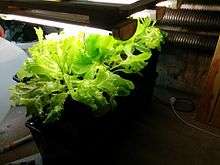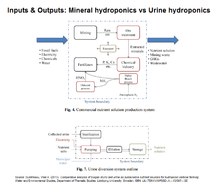Anthroponics
Anthroponics is a type of hydroponics system that uses human waste like urine as the source of nutrients for the cultivated plants. In general, the human urine or mixed waste is collected and stored for a period of time, before being applied either directly or passed through a biofilter before reaching the plants. As a form of organic hydroponics, anthroponics combines elements of both hydroponics and aquaponics systems.

History
While human waste has historically been used as a fertilizer, its use in soilless systems is a recent field of research. The earliest published research on the topic is in 1991 by researcher Guterstam, B., in which the treatment of domestic wastewater by an aquaculture and hydroponic mesocosm is described.[1]
Since then, other researchers have explored both human mixed waste and human urine as nutrient sources for hydroponic cultivation, studying the potential of such waste,[2] comparisons to traditional fertilizers,[3] both in the context of wastewater treatment,[4][5] agriculture,[6] and even space exploration.[7]
Urine as a fertilizer
Urine is 91-96% water, with urea constituting the largest amount of solids, and the rest being inorganic salts and organic compounds, including proteins, hormones, and a wide range of metabolites [8]
The urea in urine naturally converts into ammonia through a process known as ammonia volatilization from urea. This process, which can take between 5 weeks to 6 months, increases the pH of the liquid to 9, thus sterilizing it.[9][10] The time it takes for this process to occur can be drastically reduced to hours or minutes through the addition of the urease enzyme, which can be synthesized or found in watermelon seeds.[11] The sterilized and volatilized liquid is then passed through a biofilter where nitrifying bacteria convert the ammonia to nitrate, a more plant available form of nitrogen.
Given the constituents of urine and the daily amount produced per person, it is estimated that one human adult could produce almost 3 kg of lettuce from the volume of urine excreted daily.[9] Wood ash has also been used to supplement urine when cultivating cucumbers, as they require more nutrients than those found in urine.[12]
Hydroponic subsystem
After the biofilter, the water is transported to the hydroponic component where the plants are located, and where they will absorb the nutrients, cleaning the water before it returns to the biofilter. Almost all techniques used in hydroponics and aquaponics are also applicable to anthroponics. These include: Deep water culture, Nutrient film technique, and Media beds.
Advantages

Urine based solutions in hydroponics research seem to have been developed out of sustainability concerns with current mineral based hydroponic solutions. Mineral based commercial nutrient solutions are resource intensive and energy demanding, while also producing a lot of waste. The activities involved in its production include: mining, ore treatment, chemical processing, and transportation, which result in the required nutrients for the final solution. The whole process requires fossil fuels, electricity, chemicals, and water, while producing the nutrient solution, but also mining waste, greenhouse gases, and wastewater. By comparison, using urine as the nutrient source requires the collection of urine, electricity, some nutrient salts, and water, while producing no waste, limited greenhouse gases, and the final nutrient solution.[3]
Disadvantages
Some disadvantages concerning the use of urine as the nutrient source in an hydroponics system include strict laws concerning the use of human waste in food crops,[13] the unpleasant handling and odors produced by human urine, and the release of persistent organic pollutants [14] and trace metals in human urine.[15]
References
- Guterstam, B (1991). Ecological engineering for wastewater treatment: theoretical foundations and realities. In: C. Etnier and B. Guterstam (Eds.), Ecological Engineering for Wastewater Treatment. Proceedings of the International Conference 24–28 March 1991, Stensund Folk College. Bokskogen, Gothenburg, Sweden, pp. 38-54.
- Songthanasak et al (2012). Preliminary study on urine-compost extract as bio-liquid fertiliser for hydroponics Archived 2018-06-19 at the Wayback Machine. Environmental Technology Division, Agro-Industrial Technology Department, Faculty of Applied Science, King Mongkut’s University of Technology North Bangkok, Thailand
- Dumitrescu, Vlad A. (2013). Comparative analysis of biogas slurry and urine as sustainable nutrient sources for hydroponic vertical farming. Water and Environmental Studies, Department of Thematic Studies, Linköping University, Sweden. ISRN: LIU–TEMAV/MPSSD–A––13/007––SE
- Sánchez, Henrique (2014). Aquaponics and its potential aquaculture wastewater treatment and human urine treatment. Faculty of Sciences and Technology, New University of Lisbon, Portugal.
- Yang et al (2015). Application of hydroponic systems for the treatment of source-separated human urine. Ecological Engineering 81 (2015) 182–191. Copyright 2015 Elsevier B.V. All rights reserved
- Trollblad, Verånika (2016). Odling av Cucumis Sativus L. med aska från träd som näringstillägg i ett urinbaserat hydroponiskt system Archived 2016-10-22 at the Wayback Machine. Institutionen för Naturgeografi och Ekosystemvetenskap, Lunds Universitet, Sweden.
- Paradiso et al (2015). Effect of bacterial root symbiosis and urea as source of nitrogen on performance of soybean plants grown hydroponically for Bioregenerative Life Support Systems (BLSSs). Frontiers in Plant Science, October 2015 | Volume 6 | Article 888
- Rose, C.; Parker, A.; Jefferson, B.; Cartmell, E. (2015). "The Characterization of Feces and Urine: A Review of the Literature to Inform Advanced Treatment Technology". Critical Reviews in Environmental Science and Technology. 45 (17): 1827–1879. doi:10.1080/10643389.2014.1000761. ISSN 1064-3389
- Sánchez, Henrique (2015). Lactuca sativa production in an anthroponics system. Hemmaodlat, Malmö, Sweden
- Pradhan, Surendra K.; Nerg, Anne-Marja; Sjöblom, Annalena; Holopainen, Jarmo K and Heinonen-Tanski, Helvi (2007). Use of Human Urine Fertilizer in Cultivation of Cabbage (Brassica oleracea) – Impacts on Chemical, Microbial, and Flavor Quality. Department of Environmental Science, University of Kuopio. Västanfjärd, Finland
- Sánchez, Henrique (2016). Citrullus lanatus seeds as a urine catalyst for anthroponic use. Hemmaodlat, Malmö, Sweden
- Sánchez, Henrique (2016). Wood ash as a nutrient supplement for Cucumis Sativus in an anthroponics system. Hemmaodlat, Malmö, Sweden.
- EC, (2016) Sewage Sludge. European Commission, 08/06/2016
- WHO Europe, (2003). Health risks of persistent organic pollutants from long-range transboundary air pollution. World Health Organization Europe
- Perry Jr, H. M, & Perry, E. F. (1959). Normal concentrations of some trace metals in human urine: changes produced by ethylenediaminetetraacetate. J Clin Invest. 1959 Aug; 38(8): 1452–1463.